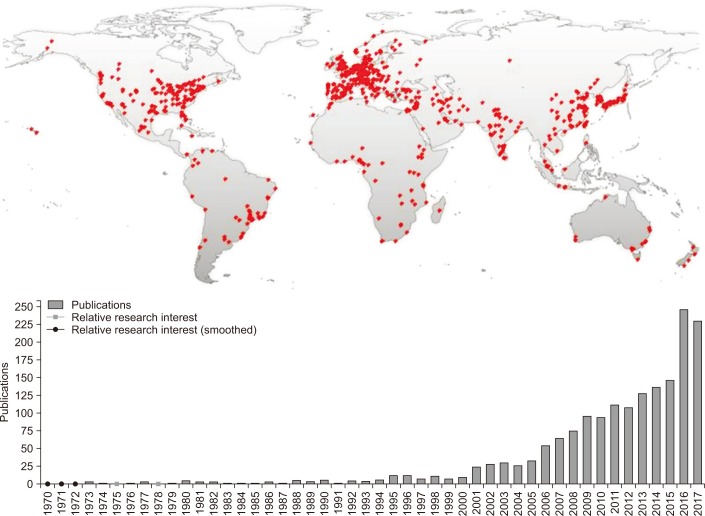Tuberc Respir Dis.
2018 Apr;81(2):163-165. 10.4046/trd.2017.0109.
Bibliometric Analysis of Research Productivity in Latent Tuberculosis: Are We Focusing Our Research Efforts on the Right Areas?
- Affiliations
-
- 1School of Medicine, Health Sciences Faculty, Universidad Industrial de Santander, Researcher GERMINA-UIS Group, Bucaramanga, Colombia. sagomezo.182@gmail.com
- 2Public Health Faculty, Escuela Politécnica Superior de Chimborazo, Riobamba, Ecuador.
- KMID: 2420605
- DOI: http://doi.org/10.4046/trd.2017.0109
Abstract
- No abstract available.
Figure
Reference
-
1. World Health Organization. Global tuberculosis report 2016. Geneva: World Health Organization;2016.2. Kawatsu L, Uchimura K, Izumi K, Ohkado A. A systematic review on the prevalence and incidence of latent tuberculosis infection among prison population. Kekkaku. 2016; 91:457–464. PMID: 27530018.3. Nasreen S, Shokoohi M, Malvankar-Mehta MS. Prevalence of latent tuberculosis among health care workers in high burden countries: a systematic review and meta-analysis. PLoS One. 2016; 11:e0164034. PMID: 27711155.
Article4. Lin PL, Flynn JL. Understanding latent tuberculosis: a moving target. J Immunol. 2010; 185:15–22. PMID: 20562268.
Article5. Lee SH. Tuberculosis infection and latent tuberculosis. Tuberc Respir Dis. 2016; 79:201–206.
Article6. Dodd CE, Schlesinger LS. New concepts in understanding latent tuberculosis. Curr Opin Infect Dis. 2017; 30:316–321. PMID: 28177961.
Article7. Donoghue HD, Spigelman M, Greenblatt CL, Lev-Maor G, Bar-Gal GK, Matheson C, et al. Tuberculosis: from prehistory to Robert Koch, as revealed by ancient DNA. Lancet Infect Dis. 2004; 4:584–592. PMID: 15336226.
Article8. Ortiz-Martinez Y. Assessing worldwide research productivity on tuberculosis over a 40-year period: a bibliometric analysis. Indian J Tuberc. 2017; 64:235–236. PMID: 28709497.
- Full Text Links
- Actions
-
Cited
- CITED
-
- Close
- Share
- Similar articles
-
- Treatment of latent tuberculous infection in children and adolescent
- An In-Depth Bibliometric Analysis and Current Perspective on Male infertility Research
- A bibliometric analysis of research productivity of emergency medicine researchers in South Korea
- Bibliometric Analysis of Dual Mobility Total Hip Arthroplasty
- Publication Trends in Osteoporosis Treatment: A 20-Year Bibliometric Analysis


